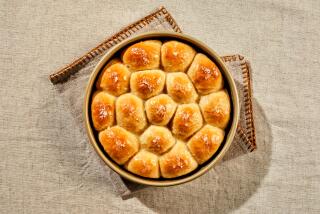How to Form Loaves for Baking Yeast Bread
We close 1989 with the last in a series of columns explaining how to bake yeast bread. Preparing, kneading and proofing the basic dough have been covered, as has one method of shaping it into a loaf by rolling and folding.
In a similar technique, the dough is formed into a 14x8-inch rectangle, then rolled in a tight scroll beginning with the short end. Pinch the seam closed, seal the ends and fold them under. Place, seam side down, in a greased pan.
Bread dough may also be free-formed into a loaf by gently pulling the top surface toward the underside to make the top smooth. Pinch the seam and turn the ends under (Step 1). Place, seam side down, in a greased pan (Step 2).
Free-form round loaves (Step 3) are prepared in the same manner. To encourage them to rise rather than spread, place in round cake pans or loosely encircle each loaf with a band of one-inch-high foil. Remove the foil after the bread has risen about halfway.
No matter the method used, the loaves should then be covered with a towel and allowed to rise until doubled before baking.
A previous column discussed the effect baking pans have on bread crust. So does brushing the dough with various ingredients before, during or after baking:
* A whole egg or egg white beaten with a little water and brushed onto the dough just before baking produces a shiny crust.
* Milk brushed onto bread gives a slightly soft or tender crust with a somewhat dull shine.
* Water brushed or lightly sprayed on baking loaves results in a crisp crust. Placing a pan of hot water on the shelf below the bread during baking creates steam and produces an even crisper crust.
Breads should be baked in a preheated oven. When done, they will appear to have pulled away from the sides of the pan (Step 4) and should slip out easily.
Test for doneness by tapping the bottom crust sharply with your fingers. If fully baked it will have a hollow sound. If not, replace in the pan and return to the oven for another five to 10 minutes.
After baking, remove bread from the pans immediately and place loaves on their side on wire racks to cool. Butter or margarine brushed on freshly baked loaves (Step 5) helps tenderize the crust.
Bread wrapped in a clean towel or loose plastic may be stored one to two days at room temperature. Wrapping breads tightly causes them to mold. For longer storage, freeze bread wrapped in foil and placed in plastic bags. Date and use within three months.
More to Read
Eat your way across L.A.
Get our weekly Tasting Notes newsletter for reviews, news and more.
You may occasionally receive promotional content from the Los Angeles Times.









